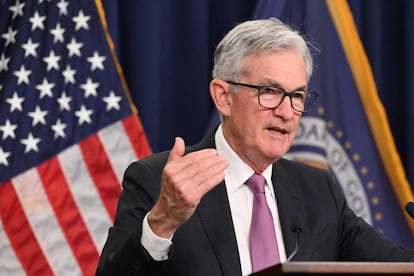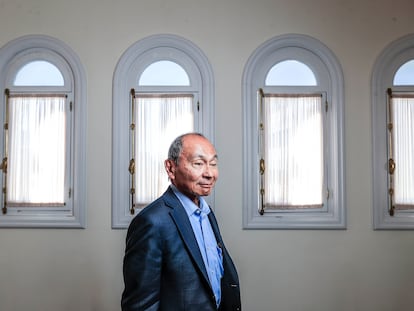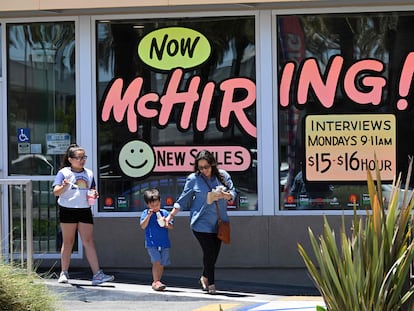Federal Reserve expected to raise rates to highest level since 2008
Chairman Jerome Powell could apply a 0.75 percentage point hike in a bid to cool inflation, while some observers say the increase will be as high as one entire point


The battle against inflation continues. The US Federal Reserve is set to raise interest rates for the fifth consecutive time this year at a two-day monetary policy meeting that begins on Tuesday.
The Fed’s efforts are aimed at cooling a skyrocketing inflation that is threatening to entrench itself in the country’s economy. Most analysts and investors expect to see a 0.75 percentage point hike, leaving rates somewhere between 3% and 3.5%. But there are those who are bracing for a one-point rise, something that has not happened since the early 1980s when the Fed chief at the time, Paul Volcker, was inflexible in his fight against rising prices caused by the oil crisis.
In any event, the move will leave the federal funds rate at its highest level since 2008, the year of a financial crisis that led to the so-called Great Recession. Since then, interest rates had never risen above 2.5%.
Powell will have a very difficult time ensuring a “soft landing” that manages to drive down inflation without triggering an economic recession
At the time when Volcker was at the helm of the Fed, its current chief Jerome Powell was a thirtysomething lawyer at Davis Polk & Wardwell, one of New York’s top law firms. Powell has always expressed his admiration for Volcker for doing what he believed to be the right thing without caring too much about outside criticism. Now, he finds himself in a similar situation.
Following the 2008 financial crisis, then-Fed Chairman Ben Bernanke and his successor, Janet Yellen, kept interest rates between 0% and 0.25% for seven years. Powell was faced with the Covid pandemic two years into his term, and made the decision to lower rates back to near zero. He kept them that way for a long time, even when inflationary tensions began to appear that he then hoped would be transitory. This year, finally, rates began to rise, first timidly (0.25 percentage points in March), then more robustly (0.5 points in May) and then twice more, at a rate not seen since 1994 (0. 75 points in June and again in July).
But even this has not been enough: August inflation fell less than expected. In addition, when the more volatile food and gasoline prices are factored out, inflation actually rose from 5.9% to 6.3%. This is a sign that the pressure on prices is still strong in a country with record employment and a jobless rate close to its lowest point in 50 years.
Investors quickly recognized that this would entail more aggressive interest rate hikes, and as a result stocks and bonds fell sharply. Anticipating increases in the official price of money, 30-year mortgage rates have already exceeded 6%, also for the first time since 2008.
“Inflation’s surprising resilience means the Fed has more work to do than previously thought,” said senior economist Bob Schwartz of Oxford Economics in a report. This expert noted that before the release of the Consumer Price Index (CPI), the general opinion was that the September 20-21 meeting would lead to an increase in interest rates of 75 basis points [0.75 percentage points] “Following the release of the CPI, that sentiment has been reversed,” he noted. “Consensus still calls for a 75 basis point hike, but now a sizable chunk of market participants thinks the Fed could, and should, be bolder, raising rates a full percentage point.”
At the recent monetary policy symposium in Jackson Hole, Wyoming, Powell warned that it would be necessary to cause “some pain” to families and businesses to contain inflation. For now, the rate hikes have hardly caused any damage to the economy. The unemployment rate continues to be very low and consumption has not suffered excessively.
Despite this, Powell will have a very difficult time ensuring a “soft landing” that manages to drive down inflation without triggering an economic recession. This is partly because he has reacted with some delay, but also partly because some of the factors that drive inflation (energy, food, raw materials, bottlenecks in the supply chain) are on the supply side and less sensitive to a moderate slowdown in demand. Economists believe the cumulative effect of interest rate hikes will kick in later this year and into early 2023, with a mild recession likely to cool demand and help contain prices.
Tu suscripción se está usando en otro dispositivo
¿Quieres añadir otro usuario a tu suscripción?
Si continúas leyendo en este dispositivo, no se podrá leer en el otro.
FlechaTu suscripción se está usando en otro dispositivo y solo puedes acceder a EL PAÍS desde un dispositivo a la vez.
Si quieres compartir tu cuenta, cambia tu suscripción a la modalidad Premium, así podrás añadir otro usuario. Cada uno accederá con su propia cuenta de email, lo que os permitirá personalizar vuestra experiencia en EL PAÍS.
¿Tienes una suscripción de empresa? Accede aquí para contratar más cuentas.
En el caso de no saber quién está usando tu cuenta, te recomendamos cambiar tu contraseña aquí.
Si decides continuar compartiendo tu cuenta, este mensaje se mostrará en tu dispositivo y en el de la otra persona que está usando tu cuenta de forma indefinida, afectando a tu experiencia de lectura. Puedes consultar aquí los términos y condiciones de la suscripción digital.
More information
Archived In
Últimas noticias
Aquilino Gonell, former Capitol sergeant: ‘If it hadn’t been for the police, the US would be a dictatorship’
A hybrid building: Soccer pitch, housing, and a shopping mall
Europe urges Trump to respect Greenland following annexation threats
Science seeks keys to human longevity in the genetic mixing of Brazilian supercentenarians
Most viewed
- Alain Aspect, Nobel laureate in physics: ‘Einstein was so smart that he would have had to recognize quantum entanglement’
- Mexico’s missing people crisis casts a shadow over World Cup venue
- Why oil has been at the center of Venezuela-US conflicts for decades
- Alvin Hellerstein, a 92-year-old judge appointed by Bill Clinton, to preside over Maduro’s trial in New York
- Cuba confirms death of 32 of its citizens in the US attack against Venezuela










































